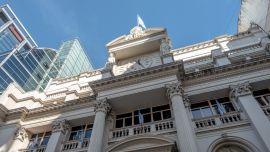Argentine officials signalled to investors in London last week they expect to receive a US$2-billion disbursement from the International Monetary Fund next month regardless of whether they miss a target for rebuilding foreign reserves just a few months into a new programme.
Investors who attended the May 14 meeting with Central Bank Governor Santiago Bausili and Economic Policy Secretary José Luis Daza left with the impression that the government would receive the next disbursement in the IMF programme that totals US$20 billion, even though neither man explicitly said so, according to people who were present and asked not to be named because the meetings were private.
As part of the new programme announced in April, Argentina’s monetary authority agreed to accumulate some US$4.4 billion in net international reserves between the end of March and mid-June. But the Central Bank’s total reserves have actually ticked down since the IMF disbursed US$12 billion in April, and President Javier Milei dismissed the need to build up reserves in a podcast interview earlier this month, citing Argentina’s floating exchange rate.
The Economy Ministry’s press office denied the officials commented on the next disbursement, but didn’t provide any more detail, while the Central Bank didn’t immediately respond to a request for comment. The IMF referred to chief spokesperson Julie Kozack’s comments in a Thursday press conference.
“There is a shared recognition with the authorities about the importance of strengthening external buffers and securing a timely re-access to international capital markets,” Kozack told reporters.
While Argentine central banks in the past have tried to build up reserves by buying dollars in the official exchange market, Milei’s economic team chose not to intervene in the peso as long as it floats within a range that started at 1,000 to 1,400 pesos per US dollar last month and gradually widens. Instead, officials have floated the idea of building reserves via debt sales, such as possibly issuing peso-denominated bonds that can be bought with dollars or another repurchase agreement.
The peso currently trades at a level of 1,135 per dollar, according to pricing data compiled by Bloomberg.
While Wall Street has cheered Milei’s efforts at eliminating some of the country’s currency controls, investors have also expressed caution over the government’s dismissal of the need to stockpile hard-currency reserves — ammunition Argentina needs to make payments to sovereign bondholders and to defend the peso, which has already lost more than nine percent against the dollar so far this year.
“If the programme is working, as it’s working now, then that metric is not going to be a problem,” Economy Minister Luis Caputo said Tuesday at a business conference in Buenos Aires, referencing reserves accumulation. “We could accumulate reserves not only through the Central Bank buying at the floor of the bands, but through the capital account.”
“And the economic programme is working very well, so we will be the example country for the next 20 years,” he added.
Argentina’s 23rd IMF programme comes after the previous deal before Milei veered dramatically off course, forcing IMF leaders to approve waivers to the leftist government at the time for missing targets in that programme — and to disburse more money. Accumulating reserves has been a weakness of Argentina’s last two IMF programmes as the currency suffered one selloff after another over the years in either official and parallel exchange markets.
by Zijia Song & Kevin Simauchi, Bloomberg



















Comments